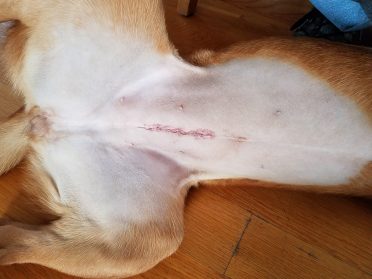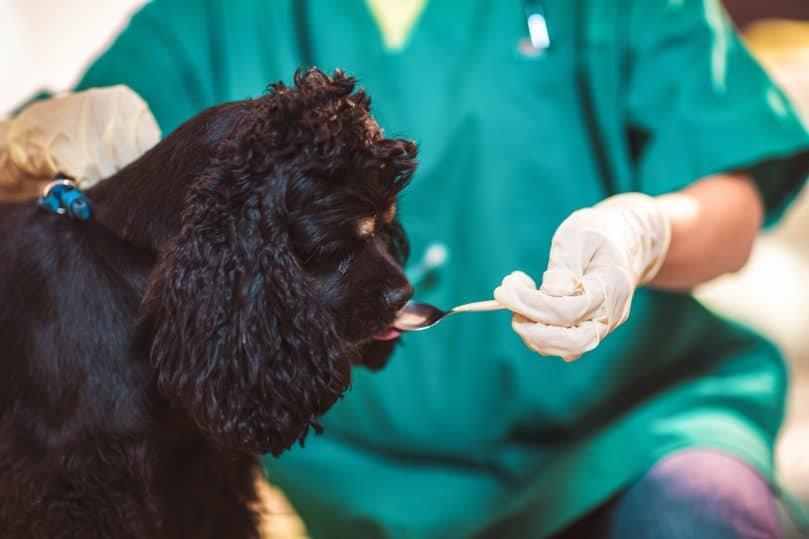This page contains affiliate links. We may earn money or products from the companies mentioned in this post through our independently chosen links, which earn us a commission. Learn More
Vaginitis in dogs is a condition of inflammation in the vagina, which results in itching and can cause pain. It’s considered to be a mild condition, meaning that it can be treated easily. Vaginitis can affect both adults and puppies. Puppy vaginitis is also called juvenile vaginitis, affects puppies before reaching puberty.
You have to take care of your dog’s hygiene, including her private parts. And we’re going to discuss one of the problems that female dogs may have – vaginitis. Let’s dive more into detail.
Contents & Quick Navigation
What is Vaginitis?
It is a condition where your dog has a swollen vaginal area with discharge or also called inflammation of the vagina.
It can occur in female dogs – both puppies and adults.
Types of Vaginitis
Always remember that you’d have to consider things, like your dog’s age, when dealing with their health and illnesses.
It will help you narrow down what you should be looking out for and what you can do to help your puppy or dog to feel better.
That is why there are two classifications of vaginitis, and it depends on how old your pet is – a pup or an adult.

Puppy Vaginitis
Also known as Juvenile Canine Vaginitis, this only happens to dogs who haven’t reached puberty yet.
Vaginitis in puppies may be caused by urinary tract infection, a congenital defect in the female dog’s private part (like inverted vulva), or even feces contamination.
Pups who are suffering from this condition may have a swollen vaginal area. You may also notice that your dog has been licking herself more often or there’s discharge from her vagina.
This type of inflammation is not usually life-threatening, but it can develop into a bacterial infection. Take care of your pet by gently wiping the vulva or vaginal area of your puppy using unscented baby wipes or mild soap and water. This will help relieve her of any irritation or discomfort.
Puppy vaginitis usually goes away on its own as your pup matures. But if it’s getting or worse or the condition is persistent, the vet may prescribe an antibiotic to help treat the symptoms of the vaginal inflammation.
A simple test, such as a urinalysis, can help find out if there are any underlying concerns or you would just have to deal with the cause(s) of vaginitis in your puppy.
Adult-Onset Canine Vaginitis

Vaginitis in adult dogs can be caused by a uterine or yeast infection, or be the result of a disorder in the urinary tract.
Adult-onset vaginitis is more common in spayed dogs who have already reached maturity, compared to females who are still intact.
Aside from the common signs like frequent licking and discharge, your dog will experience urinary problems such as peeing more than usual or having accidents indoors.
If your dog has an existing medical condition such as diabetes or liver disease, the symptoms she experiences can be more severe.
Although there is a broad spectrum of nondairy probiotic for dogs out there, have your dog checked by a veterinarian first. Generally, vaginitis can mask other illnesses so you have to be sure you’re giving the right medication and amount.
You also have to avoid wiping or cleaning your dog’s vaginal area as it may worsen the problem.
Symptoms and Causes of Vaginal Inflammation
It is evident that your dog is showing you that something’s wrong. She’s obviously uncomfortable with all the constant licking and frequent urination, but there are a lot of factors to consider. Is your dog’s vaginitis temporary or chronic?
It can be hard to pinpoint the exact reason why your dog has vaginitis, that’s why you have to watch out for more symptoms that your pet is displaying.
Take note of the color of the discharge (if there’s any) – it can be whitish-yellow, or it can contain blood which rarely happens.
Not only will you notice that your dog is in pain because her vagina is red and swollen, but she would also scoot her bottom across the floor, and male dogs are showing interest in her, too.
And here are the possible causes of vaginitis in your puppy or dog:
- Irritation from fecal matter or urine
- Foreign body migration
- Vaginal Neoplasia
- Anatomical anomaly
- Urinary incontinence
- Bacterial Infection (canine Brucellosis)
- Canine Herpesvirus
- Ectopic Ureter
- Vaginal Abscess
- Uterine Stump Pyometra (where there’s residual tissue after an ovariohysterectomy)
- Ovarian Remnant Syndrome (when your dog still goes into heat despite being already spayed)
Here’s a short video of a vet explaining some possible causes of urinary infections in dogs.
Diagnosis of Vaginitis in Dogs
Just like with the symptoms and causes, diagnosis and treatment will also vary and depend on the age of your dog and how severe the inflammation is.
As we mentioned earlier, go and talk to your vet before you try any home remedies or homeopathic cures. Keep in mind that the common symptoms of vaginitis might be masking other health concerns in your dog.
Get a professional opinion before treating your pet on your own. All you have to do is be ready with all the information your dog’s medical history and other essential details about the current condition – when it started, how it looks like, how the dog behaves, and more.
The vet will then conduct diagnostic tests which include physical exams, blood tests, fecal tests, urine tests and culture, antibiotic sensitivity tests, vaginal cultures and vaginoscopy, and cytology studies.
Vaginoscopy or x-ray may be required if there’s a concern that the vaginal inflammation developed because of tumors or cysts.

Treatment options for vaginitis in dogs
If you have a puppy who is suffering from juvenile vaginitis, she doesn’t need to undergo surgery or get hospitalized. It’s just a phase she’s going through. The inflammation and other symptoms would go away on its own after her first heat or estrus.
But if the vet prescribed a topical medication to relieve your pet from discomfort, she might have to wear a neck cone.
The cone, also called Elizabethan collar, would not only stop your dog from licking, but it will also let the cream work and let the skin heal undisturbed.
If you want her to get spayed, it’s best to wait for her first estrous cycle is over before making her go through the procedure.
If bacterial infection caused the inflammation, the vet would prescribe antibiotics, and if needed, he or she might also require you to administer antiseptic to control the disease.
Other than that, some dogs would have to have their ovaries and uterus completely removed as the condition is not treatable anymore. Older female dogs may benefit from getting spayed if they get vaginitis while they are still intact.
Helping your dog recover from vaginal inflammation
Your beautiful dog can still feel sore for a few more days or longer.
As a loving owner, we would do anything to speed up our pet’s recovery and prevent her from getting vaginitis again.
You can help your dog get better by making sure she has a stress-free and clean area or space.
If she was sent home to take medications such as anti-inflammatories or estrogen therapy, adhere to the vet’s instructions.
And whether your dog has undergone surgery or not, don’t ever stop administering her treatment and medicines in the middle of the course! Even if you think that your dog is back to normal and feeling better.

Your vet might also recommend that you change the last soap or shampoo you are using on your dog. He or she would probably advise that you switch to a milder one to reduce and prevent irritation, especially when cleaning your dog’s vaginal area.
Just be patient, and your dog would be back to her bubbly, healthy self, generally around two to three weeks from the time she started her treatment.
If your pretty doggo has experienced vaginal inflammation or currently have this condition, let us know about it. Share your story, ask questions, or give tips to help fellow dog parents by leaving a comment below!

1 reply on “How to Deal With Your Dog/Puppy’s Vaginitis”
These days not everyone can afford to pay for a vet, you never know what the final bill will be. I was one of the first patients of my vet when she opened her practice a zillion years ago, and have been until now. I asked if I could split the visit into 2-3 payments. “we don’t take payments”.
well. so I have to try and treat this vaginitis myself and there are 100 cures on the internet.